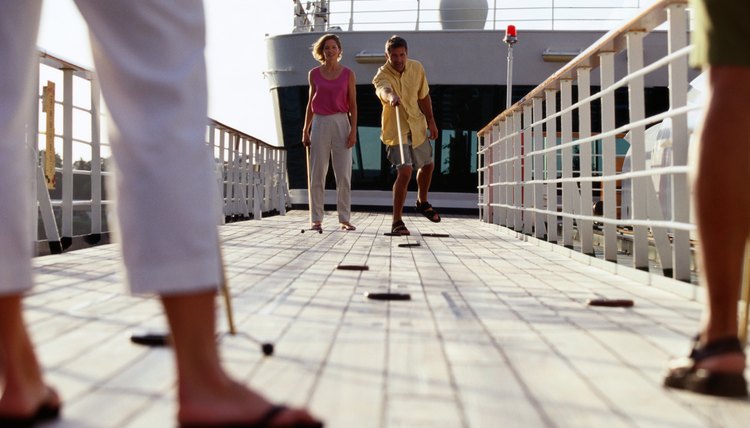Rules of Outdoor Shuffle Board

A modern version of an old English game named shovelboard, outdoor shuffleboard is generally associated with senior citizens due to its prevalence at senior centers and relative ease of play. Yet the game contains elements of strategy and competition that make it appropriate for all ages. The National Shuffleboard Association sets the rules for the competitive version in the United States. There is an indoor shuffleboard, but it's played on a table. The outdoor game is played on a painted court.
What You Need
A standard outdoor shuffleboard court is a rectangle 52 feet long by 10 feet wide. Each end has a baseline and a triangle divided into five sections, each marked with a certain number of points. Below the triangle is an area marked “10 Off.” “Dead lines” mark the 12 foot section in the middle. Each player needs a set of colored discs 6 inches in diameter and between 9/16 inch and 1-inch thick. Yellow and black are the traditional colors, but other colors are acceptable. Each player also needs a cue, a pole with two prongs at the end. The cue may be no longer than 6 feet, 3 inches.
How to Play
Shuffleboard is played in half-rounds. For each half-round, the players alternate using the cue to slide discs from the 10-Off section of one end of the court toward the scoring triangle at the other end. Yellow plays first. Discs that don't reach the far dead line, or slide past the 10 Off section, are removed from play, as are those that are played illegally. The other discs stay in play. The goal is to score points with your own discs while knocking your opponent’s discs into the 10 Off area or keep him from scoring.
Keeping Score
Scores are tallied at the end of each half-round. Players get the marked number of points for any disc fully within a section of the scoring triangle. Discs that rest on a line are not scored. Deduct 10 points for any disc that sits within the 10 Off area. The game continues until one player reaches 75 points. Once that happens, play continues until the end of the half-round. If the other player also reaches or exceeds 75 points, the one with the highest score at the end of the half-round wins.
Penalty Considerations
The National Shuffleboard Association maintains a long list of penalties for tournament play. In more casual games, penalties are generally limited to offenses that directly affect the score of the half-round. For example, Washington State’s Crestview Condos penalizes its players for playing an opponent’s disc, leaning over the baseline while shooting, and allowing a disc to touch the 10 Off line before playing that disc. Discuss the penalties you will use with your opponent before the game begins.
References
Writer Bio
Lisa Fritscher is a freelance writer specializing in disabled adventure travel. She spent 15 years working for Central Florida theme parks and frequently travels with her disabled father. Fritscher's work can be found in both print and online mediums, including VisualTravelTours.com. She holds a Bachelor of Arts in psychology from the University of South Florida.
